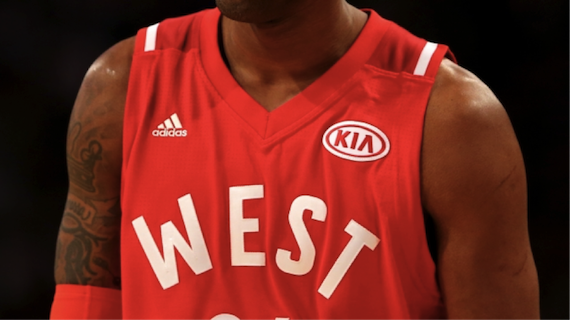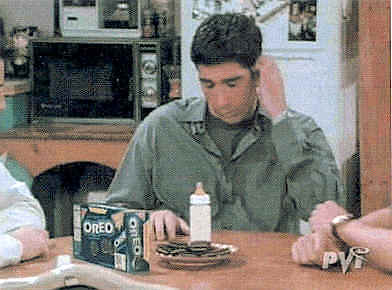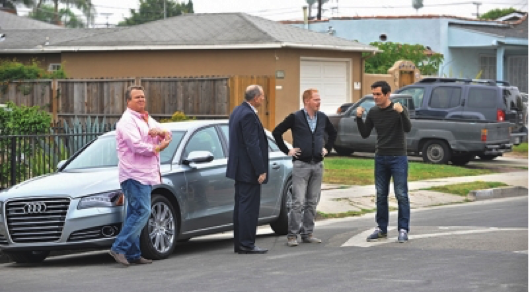Media Literacy: Learning about Product Placement
To advertise or not to advertise? That is often the question when organizations are concerned about reputation and companies ask about branding opportunities.
Some might reluctantly say no, but that’s less true among sports organizations where athletes are increasingly becoming personal billboards for multiple brands.
Case in point: the National Basketball Association. The NBA recently announced that players will sport ads on their jerseys starting with the 2017-2018 season.
Apparently, at this point at least, the ads won’t be big and splashy. According to this blog post: they “will take the form of a patch on the front left of the jersey, measuring 2.5 inches by 2.5 inches. The (new) Nike logo (replacing Adidas) will occupy the same position on the other side of the jersey.”
(what an ad might look like on the front of an NBA player’s jersey)
The NBA’s commissioner predicted the ads will be worth about $100 million dollars a year. It’s not an insignificant amount, but the NBA makes most of its money from its broadcasting contracts. The league’s total revenue for 2017-2018 is predicted to be a whopping $7 billion.
Why should we care?
Do you or your students even care about news like this? You might not see value in having your students take the time to consider whether product placement is a good idea or why teams would do it. But in case you do, I’d like to offer you some ideas for consideration.
In an earlier post – “Making Sure Your (Brand) Name Gets Out There” – I noted the proliferation of advertising in our world and how educators can use this topic as one of the hooks to engage students in ways that encourage critical thinking and media literacy.
Analyzing ads also helps meet the Common Core ELA standards for argument.
“Ads are, after all, arguments,” says rhetoric professor Renee Shea. “As such, they engage students in critical thinking about claims, assumptions, counterargument, types of appeals, logical fallacies, and audience—basic elements of rhetoric.” (Source)
But these NBA product placement ads aren’t just any advertising. They’re not in a magazine or on TV, and they can’t be clicked away by the viewer: they’re ads on clothes. Many middle school students are already walking advertisements themselves – mostly for clothes and shoe brands. (Do they realize that?)
“Branded” entertainment
The NBA jersey ads are a variation on what has become known as “branded entertainment” or “product placement,” and they exist just about everywhere, but are most prevalent today in movies and television.
The idea is simple: put the ad inside the content the viewer wants to see (as opposed to a commercial which resides outside the content) and the audience won’t be likely to skip (fast-forward) past it.
When an actor (or player) actually holds or appears to be using the product, it becomes a “celebrity testimonial” and can influence consumer purchasing decisions.
Oreos (box and plate) digitally inserted into repeat of “Friends” (Source)
Audi used in an episode of “Modern Family” (Source)
In the case of “Friends” (pictured above) the product is virtual – it’s been electronically placed into the scene after filming. This digital insertion technology is used in baseball games where ads are superimposed on top of a green screen behind home plate. And Modern Family’s willingness not only to place products in scenes but also to place messages inside the show’s script was revealed in a recent Associated Press story.
In a movie or TV show, the actual product might be seen on-camera for anywhere from a few seconds to a few minutes, depending on the contractual agreement between the advertiser and the producer of the program. In an NBA game, with the camera focused on the players, the “ad” (while smaller) most likely will be on the screen for a much longer period of time, including in many close-ups.
Thinking about student engagement
So, a media literacy approach to this issue might start with an educator posing questions for students to consider. For example:
| Questions: | Answers: |
| What is product placement and how does it work? | Students could research this. |
| Who makes up the audiences for NBA games? | Students could research this. |
| Who made the NBA decision regarding jersey ads ? | NBA’s Board of Governors |
| Who benefits (and who does not) from the ads on jerseys? | 50 percent of the money from uniform ad deals would be kept by teams, while the other 50 percent goes into a revenue-sharing pot. (Source) |
Ask students on which TV programs they might expect to find product placement. (e.g. might “The Amazing Race” lend itself to travel products or services?)
When we consider just sports programming, for example, it’s easy to spot ads during any NASCAR broadcast. The cars and the driver’s uniforms are full of product logos.
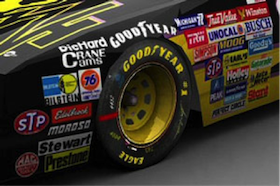 But is advertising in other sports so prevalent? Assign students another sport: tennis, hockey, baseball, football, soccer, golf, etc. You might ask students to watch a typical broadcast and document ad or logo placement in say 15 minutes of a given sport – noting each ad/logo and how much time (seconds or minutes) the advertised product was on screen.
But is advertising in other sports so prevalent? Assign students another sport: tennis, hockey, baseball, football, soccer, golf, etc. You might ask students to watch a typical broadcast and document ad or logo placement in say 15 minutes of a given sport – noting each ad/logo and how much time (seconds or minutes) the advertised product was on screen.
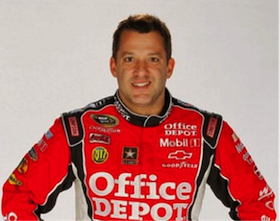 Have them conduct an “image search” of other sports and present their findings. Which sport or sports appear to have more product placement ads (inside the main content) than the others?
Have them conduct an “image search” of other sports and present their findings. Which sport or sports appear to have more product placement ads (inside the main content) than the others?
What about those advertisements inside and outside your own city or school sports arenas and stadiums? Have students noticed those? Did they ever consider the placement or appropriateness of these ads and who benefits? (If they look closely enough, they might even find product placements inside the school itself.)
Suppose you divide the class in two: one group researches the “pros” of product placement in TV and film while the other investigates the downsides. This writer for Forbes dives into some of the pros and cons, but I am willing to bet your students might go much further with this topic.
I’d be interested in hearing from you about this topic. Did you use it in your classroom? If so, how did students react? Use the comment section below to post your observations.
Additional Resources on Product Placement:
Huffington Post’s Product Placement Thread
Everything You Should Know About Hidden Product Placement (Infographic)
The Sneakiest Product Placements in Entertainment (Infographic)
Campaign for Commercial Free Childhood
Frank W. Baker maintains the nationally recognized Media Literacy Clearinghouse website. He is a media literacy education consultant and the author of three books, including Media Literacy In the K-12 Classroom (ISTE, 2012). He contributed two chapters to Mastering Media Literacy (Solution Tree, December 2013). In November 2013, Frank was a recipient of the National Telemedia Council‘s annual Jessie McCanse Award given for individual contributions to the field of media literacy over at least 10 years. Follow him on Twitter @fbaker.


